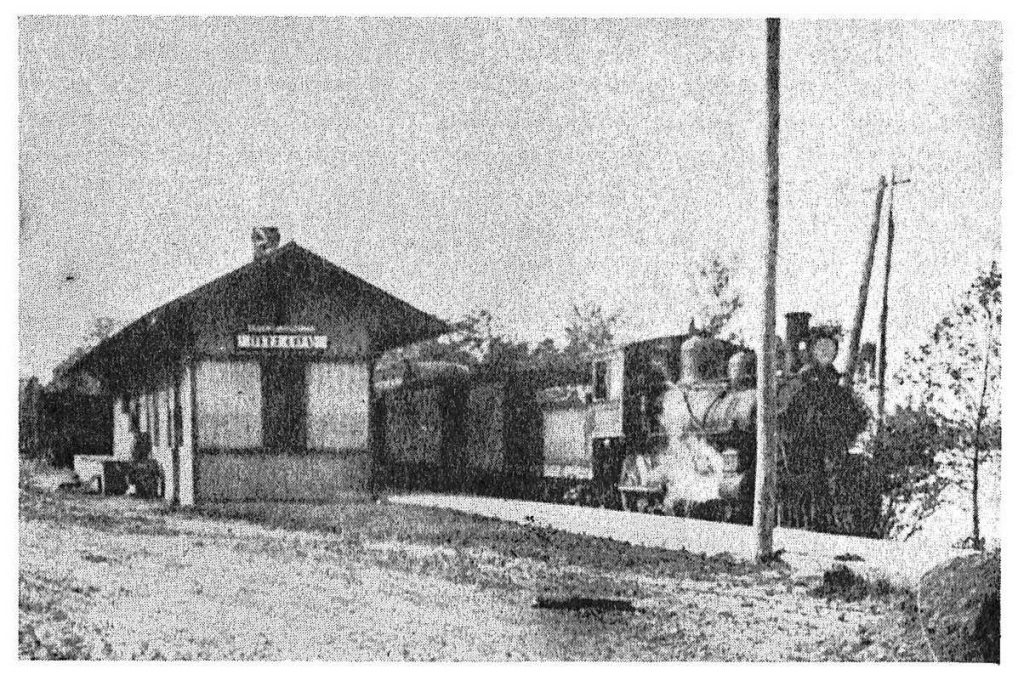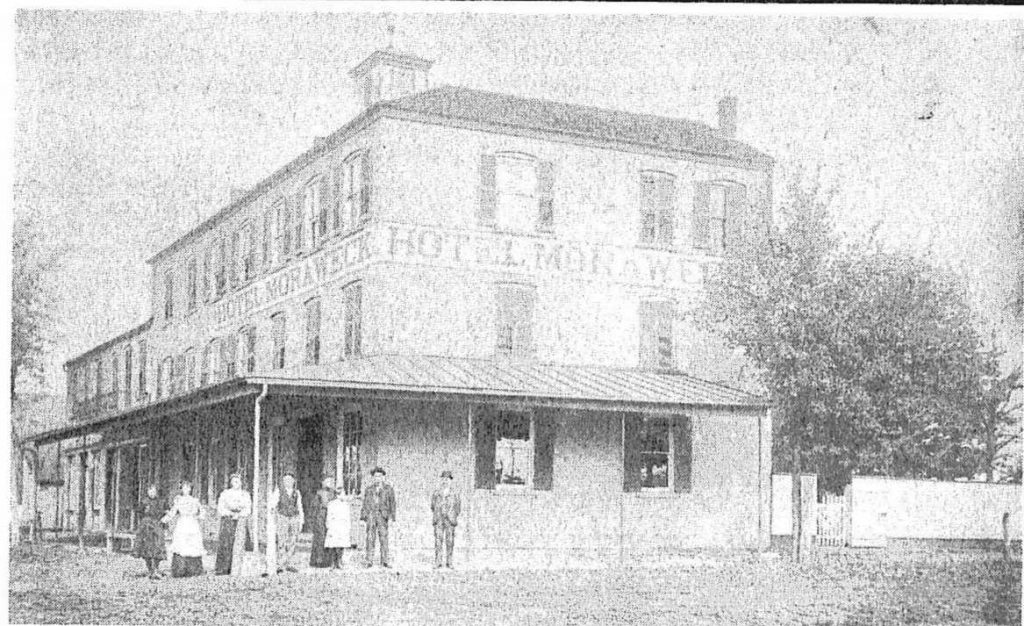
First Railroad station
CITY RAILROAD STATION is pictured above with “The Southern” stopped there on its way to Llncoln City. We were unable to procure a picture of the original or earlier model locomotive used when the line made its first run the last day of 1887. For the complete history of the railroad in Tell City, read the story on that subject in this Supplement written by Mrs. Ed Harrer. The depot in the picture was destroyed by fire and replaced by the station on South Main street between Blum and Gutenberg streets.

THE MORAWECK HOTEL was one of the city’s most popular hostelries in the early days. It sat at Blum and Seventh streets at the top of the levee road which extended from the river wharf to this street intersection. After the railroad was built it was located just across Blum street from the railway depot. Anton Moraweck, the proprietor of this hotel, was the grandfather of Miss Erna Coldewey. The accompanying picture of this hotel was furnished by Miss Coldewey. In the group (l to r) are Willie Krogman, Anna Brinkman, Tillie Boehn, Mr. Moraweck, Mrs. Claudina Coldewey, Erna Coldewey. The other two men on the right end of the group are unknown.
The First Railroad Train Arrived In Tell City December 31, 1887
Mrs. Ed (Clara Patrick) Harrer
Tell City business men early felt the need of contact with the outer world by some means of transportation more speedy than that offered by the river boats. A number of different plans for this were considered. Jasper proposed connecting us with Newburgh, Rockport, Grandview, Troy and Cannelton, with Leopold, finally joining Airline (name of train line) somewhere in Crawford County. This was to have been called the Chicago, St. Meinrad and Ohio River Railroad. The election to decide on approving this route held in various towns and counties in early 1882 to see whether this road should be built. The vote In Perry County was 473 for and 16 against. Our county might have saved its adoption by the addition of a very few more votes to overcome losses in other counties. It was the Hagedorn voting place in Anderson Township where the vote for this road met most opposition. So much antagonism for project was shown here that A. P. Menner angrily called the Tell City promoters in favor of road a “band of thieves”.
Second try Successful
It was some time before Tell citizens again made an effort to secure a railroad. The Louisville, and St. Louis line, (now the southern) usually called the Airline because so much of its track was built on trestles, helped Tell City organize a branch line connecting us via Lincoln City in Spencer county with the main line in Huntingburg, Indiana. Citizens in Tell City voluntarily subscribed a certain amount of money for the project. Some records say this was $15,000 and some say $10,000.00. It is difficult to determine just how much was raised but it was not less than $10,000.00. In September, 1886, an election was held to determine whether citizens were willing to have a 2% tax levied for the road, the result 455 for and 15 against. An ordinance was passed granting right of way.
Signs of Indian Battle
When the ground was broken in preparing the road-bed through Perry county, some of our pre-colonial history was revealed, for there were unmistakable evidences that Indians had fought a battle between Troy and Tell City at some unknown early date. Every school boy assembled a fine collection of flint arrowheads, tomahawks and other artifacts uncovered in the road building process.
Work progressed and on December 29, 1887 Mayor August Schreiber received a letter from the office of the railroad in New Albany announcing that the first train, would arrive on December 31, 1887, and inviting him to ask all citizens of Tell City to participate in a public reception of the long awaited “Huntingburg, Tell City and Cannelton Railroad”. Mayor Schreiber was personally to go to Lincoln City and ride in on the first train. It was an honor he had well earned for he had exchanged a great many letters with the New Albany headquarters office, all written in longhand, urging the expediting and completing of this much desired link with the world outside.
Holiday Declared On the appointed day all factories and business houses closed at noon. Everybody went down to Sixth Street and watched and listened intently for the approach of the “iron horse” and never a locomotive whistle sounded more musical and rattle of wheels on the track gave a greater thrill than the new train gave Tell Citians on that memorable day. The locomotive drew two open platform coaches (such as were used for transporting materials) and a caboose.
Not a very grand display, but Queen Elizabeth II’s horse-drawn carriage at her coronation never looked finer.
The Mechanics Band went aboard and played a jolly tune as they left the station on the way back toward Lincoln City. All went well until they approached Troy, where a stubborn cow refused to budge off the track. The train stopped and “Bossy” had to vacate much against her will. At Evanston another stop was made for transaction of business. Here the Mechanics Band regaled passengers and town folks with a free concert.
Students Given Free Ride
In the spring of 1888 before school closed for the summer vacation, public school pupils were taken for a free train ride and an all day picnic at Kennedy’s Station just beyond Lamar in Spencer county. The picnic site was at the foot of a hill, at the top of which lived David Kennedy, the father of our present citizen, W. H. Kennedy. It was a memorable experience for Tell City children and most of the grown ups (now in ‘their 70’s and 80’s) who were passengers on I that trip remember it as their very first train ride.
The first passenger depot was in a rented building on the southeast corner of Seventh and Washington Streets, known as the Oelkers building. It occupied the site where the pumping station now stands.
An old box car served as a freight depot from 1888 to 1898 when a rudely constructed building was erected at Pestalozzi and Sixth streets to replace the box car.
First Depot In 1899. Finally in 1899 a frame passenger and freight depot was erected on the site of the present brick structure. It was a far, cry from the imposing structure Tell City had hoped for but at least better than none at all. On January 6, 1914, this frame depot burned and most of the contents. Rumor whispered the blaze might have been purposely started by some malicious human, but this was never proved.
Business on the railroad was very good at this time and something had to be done to replace the building. On February 28, 1914, plans for a real “honest-to-goodness” brick depot were accepted. The erection began at once. While the work went on, a passenger car on a siding served as a temporary depot.
Six Trains Daily.
In the beginning six trains a day -three out and three back -four passengers and two mixed -served Perry county. This continued for years, but when improved highways and automobiles began to come in around 1932, the railroad lost much patronage and deemed it necessary to reduce its service to one mixed run in and one out. When even this did not yield what the railroad people regarded as an adequate return they again reduced, in the year 1939, to one freight run in and one freight run out daily, eliminating all passenger service. Then came the last reduction, which is now in practice. This allows us freight service six days a week, with one freight train in and one out.
Six Employees At One Time
At one time the business in the Tell City station was so heavy that it required six men to care for it; now there are only two needed. Part of this is due, of, course, to encroachment of extensive motor traffic, but not entirely so. Perhaps the centralized accounting system introduced by the Southern Railway in late years is even more responsible for the reduction in number of station employees.
The Southern Railway has only Seven miles of road and two depots in Perry county. On this property the 1956 county tax was $4,456.00. The railroad people regard this as a heavy toll.
If one doesn’t drive an automobile, Tell City is one of the most difficult towns to travel from or to. How we do miss that old passenger service we let slip a way from us after the arduous effort to get it by our forefathers.
Prominent In Project
The citizens prominent in pushing for the branch line of the railroad into Tell City were: August Schreiber, J. C. Harrer, John Hermann, Dr. William Cluthe, Christian Zoercher, Peter Wiedmer, Louis Koch, Jost Fischer, Ferd Boecker, Charles Steinauer, Gustave Huthsteiner and Fred Kaelin. They began working for the realization of this project as early as 1885. All their meetings were Conducted in the German language. Fred Kaelin was their secretary and Charles Steinauer the chairman. At first there was some debate on the question of whether they should build a narrow gauge or standard gauge road. The reason some preferred the narrow gauge was that it would cost less, but the standard gauges won the argument on the ground that it would offer a more effective connection with outside lines.
Tell City changed from a “town” to a “city” form of government so it could carryon negotiations with the railroad magnates in a more business like manner. August Schreiber was the first mayor.